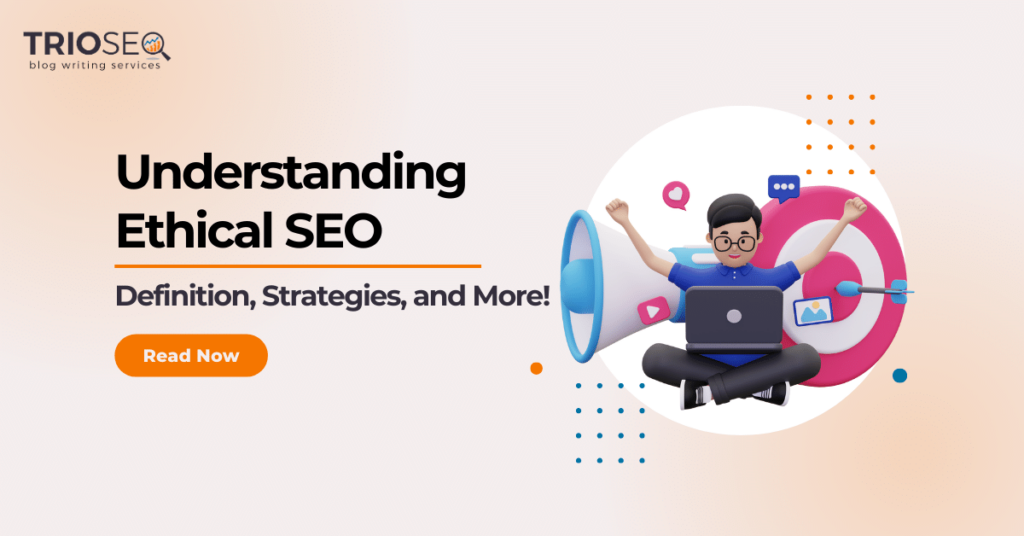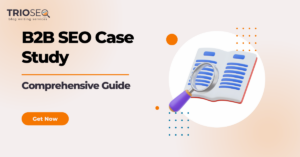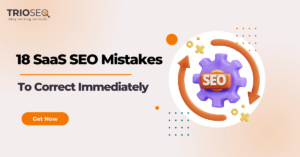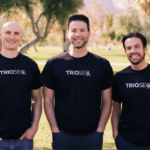Search engine optimization can seem complicated, but at its core, it’s actually quite simple. We all just want to rank at the top and drive tons of traffic to our sites.
But things can get ethically murky pretty fast in the quest for high rankings.
What’s considered crossing the line? And how do you balance ranking success with moral integrity? Questions of right and wrong permeate every industry, and SEO is no different.
In this comprehensive guide from our expert SEO consulting team, we’ll explore what exactly ethical SEO entails, its key benefits, and the top white hat techniques you should implement.
So, let’s get right into it!
What is Ethical SEO?
The definition is something like:
“Ethical SEO refers to optimizing websites through legitimate tactics endorsed by search engines like Google and Bing. The focus is on providing value to users through high-quality content and positive experiences.”
But it’s not that simple. Bots don’t have an inherent sense of right and wrong. Search engine ethics depend on the people programming them.
So Google might give specific tactics a green light while Bing bans them. Your SEO strategy could be by-the-books ethical on one engine but totally shady on another.
It’s a messy gray area. Just look at structured data markup – we slip engines “cheat sheets” to rank better. Google smiles upon it while others don’t.
So, who decides what’s virtuous?
We do.
Every website inherits the ethics of the actual humans behind it, for better or worse. That determines if our optimization crosses into manipulation.

What is White Hat SEO? Are They The Same?
We use the term “White hat SEO” as synonymous with ethical SEO. However, there are some key differences.
White hat SEO means playing by the rules set by search engines like Google. If Google says, “Don’t do this,” you don’t.
Ethical SEO is more than just following guidelines. It also means doing what’s best for the people visiting your site, not just the search engines (in most cases, they can be the same).
So something could be white hat SEO but still be unethical if it tricks or confuses visitors and provides wrong information that harms people.
And something could break the rules a little bit (like telling a fun story) but still be ethical if it helps people.
Here’s an easy way to think of it:
- White hat SEO is about making the search engines happy by following their rules.
- Ethical SEO is about making search engines and human visitors happy by doing stuff that helps them.
They’re related, but ethical SEO cares more about doing what’s right overall.
Some core principles of White Hat SEO include:
- Creating content that offers true value to readers.
- Building links naturally via marketing efforts.
- Designing easily navigable website layouts.
- Optimizing pages for speed and mobile-friendliness.
- Following search engine guidelines and best practices.

Benefits of Ethical SEO
Doing SEO the right way with an ethical SEO consulting company has some big upsides. Here’s why ethical tactics are worth it:
- You get real staying power in the search engines. Shady tricks might help at first, but ethical sites built to last get better rankings over time.
- You get peace of mind. Optimize without constantly worrying if your site will get hit by an update. Ethical SEO brings reliable results.
- People learn to trust and believe in your brand. When you make your site to help visitors, they notice and return more.
- No need to stress over penalties. Google and others don’t crack down on ethical techniques that follow the rules.
- Your audience can grow larger. Making your site easy to use for everyone means more potential customers can visit.
- The experience is better for visitors. Fast loading times and mobile friendliness keep people happy when they check you out.
While it takes more patience up front, you end up building a solid brand that both search engines and real users value. That pays off hugely in the long run.
The key is focusing on actually helping people, not just gaming the system. When your site provides something useful, ethical SEO comes naturally.

What is Unethical SEO?
Unethical SEO means using shady tricks and loopholes to rank higher in search results unfairly. The goal is to fool or manipulate search engine algorithms for quick traffic gains.
These tactics might work at first but almost always backfire with huge penalties from Google. They also make your site less trustworthy to visitors.
Some common unethical strategies to avoid:
- Keyword stuffing – Cramming pages with keywords that don’t fit naturally, often using hidden text or repeating words far beyond what a human would write.
- Invisible text – Using white text on a white background or tiny fonts to sneak in keywords that users can’t see.
- Cloaking – Showing search bots one version of a page (optimized for SEO) while showing real visitors something totally different.
- Sneaky links – Disguising backlinks so they blend in with normal text, often by using matching colors. Misleads users.
- Scraping – Simply copying and reposting other people’s original content without permission, attribution, or adding value.
- Doorway pages – Creating low-quality pages targeting specific keywords but providing visitors little value.
- Redirect manipulation – Programming links to send users and search bots to entirely different pages. It confuses both.
- Spamming search engines – Bombarding engines like Google with automated bot-generated queries to try and boost traffic. Though AI-generated content isn’t against Google’s guidelines (“as long as they’re helpful to users,” as Google says!), this is totally unacceptable.
- Link schemes – Exchanging backlinks with other sites purely to manipulate PageRank, not because the sites are related or useful.

SEO Ethics Explained
SEO strategies generally fall under three categories representing escalating levels of risk:
White Hat SEO (Ethical)
As described earlier, white hat SEO adheres fully to search engine guidelines through organic tactics benefiting users.
A few examples:
- Doing keyword research to optimize pages for terms people actually search for. This helps searchers find you.
- Writing original and well-researched humanly written blog posts that thoroughly cover topics readers care about. Valuable content earns trust and links.
- Getting references from industry websites through relevant guest post outreach, PR efforts, etc. Natural links point to expertise.
- Fixing site errors that hinder crawling. Ensures search bots can fully index your content.
- Speeding up load times through code optimization. Faster sites keep visitors happy.
If you need help executing white hat SEO best practices, our team at TrioSEO has the expertise.
We specialize in ethical on-page optimization and SEO blog article writing. Get in touch to learn how we can sustain your brand as a trusted resource, implementing white hat SEO techniques and exceeding visitor expectations.

Black Hat SEO (Unethical)
Black hat SEO violates policies through deception intended to exploit loopholes in search algorithms. Some common tactics include:
- Stuffing pages with semi-related keywords solely to rank for more terms. It feels manipulative.
- Using content spinners to auto-generate pages from just a few seed articles. This completely lacks original value.
- Buying links from ad farms or spammy directories. It is also seen as manipulative. Remember those good old PBNs (Private Blog Networks)?
- Blocking search bot access to thin, low-value doorway pages. Deceptively hides poor content.
- Copying competitors’ content without adding anything new. This would be unethical theft.
Such practices damage credibility and invite penalties during core algorithm updates.
Grey Hat SEO (Not Entirely Ethical)
Grey hat SEO is like the Wild West of optimization – not entirely legal, but not quite illegal either. It lives in a grey zone somewhere between perfectly safe white hat tactics and clearly banned black hat tricks.
The risks and sustainability also land somewhere in the middle.
Examples of grey hat SEO include:
- Over-optimizing pages to target hyper-specific long-tail keywords unrelated to the overall site.
- Automating personalized outreach for links without customization. Efficient but borderline spam.
- Repurposing ghostwritten posts with minor changes. Lacks originality but adds some value.
- Piggybacking on trending news tangential to your niche. It’s not fully manipulative but also not entirely original.
- Creating pages mainly to attract links rather than inform visitors. User experience takes a backseat.

Top 10 Ethical SEO Techniques
Implementing ethical SEO takes dedication, but the long-term payoff is immense. Here are 10 of the most effective ethical SEO techniques to help your website rank higher and build trust:
1. Conduct Thorough Keyword Research
Proper keyword research with an understanding of keyword types ensures you analyze user search intent and can create optimized content accordingly.
Use tools like Google Keyword Planner and SEMRush to identify high-traffic, relevant terms and long-tail variations to target.
This helps searchers easily find your pages when seeking those topics.
2. Optimize Page Titles and Meta Descriptions
Page titles and meta descriptions act as your website’s “digital storefront” in search results. Make sure titles concisely convey the page topic in under 60 characters using target keywords.
Craft compelling meta descriptions of 115-160 characters that entice searchers to click through. Include keywords naturally – over-optimization looks spammy.
3. Implement Quality Internal Linking
Proper internal linking between your web pages enables easy site navigation and helps pages share “link juice.” Use a crawler like Screaming Frog to analyze your internal link structure.
Connect related pages with contextual text links and improve cross-linking between content pillars. This allows search bots to crawl your site easily.
At TrioSEO, we leverage the hub and spoke model for content planning and optimizing internal linking. This strategy involves creating an anchor hub page that numerous authority and silo pages link back to.
4. Create Engaging, Original Content
High-quality content that offers true value demonstrates expertise and meets searcher intent. Ensure all content is 100% original – never scrape or repurpose existing copy.
Incorporate storytelling, data, polls, and multimedia to provide depth that searchers appreciate. Aim for at least 2,000 words of well-researched info per piece.
However, avoid adding unnecessary fluff just to hit higher word counts. Cover the topic thoroughly but concisely, using an appropriate word count matching the subject matter’s depth.
5. Enhance Site Speed and Mobile Responsiveness
Site speed significantly impacts user experience. According to Google, page experience is now one of the most important ranking factors.
Use tools like Pingdom and PageSpeed Insights to test site performance. Diagnose and fix speed issues to improve page load times.
Also, optimize for mobile with responsive design. Google favors mobile-friendly sites – use their Mobile-Friendly Test to check yours.

6. Build Links Naturally via Outreach
Natural link-building through outreach demonstrates genuine trust and relevance. Start by identifying industry websites and influencers to connect with.
Craft personalized emails pitching relevant guest posts or simply brand mentions. Be helpful, not salesy. This forges real connections, leading to earned backlinks to boost your SEO.
7. Leverage Social Media for Exposure
Promote your best content across social media to amplify reach. Share posts on platforms like Facebook, Twitter, LinkedIn, and Pinterest.
Encourage social sharing and follows. 73% of marketers say they use social media to improve website visibility and search rankings.
8. Create and Update Sitemaps
XML sitemaps help search engines discover new pages. Create a sitemap of all site pages through Yoast SEO or a plugin.
Update sitemaps whenever you publish fresh content. Submit the sitemap to the Search Console for prompt indexing.
9. Add ALT Text to Images
ALT text provides a textual description of images to help search bots understand them. It also benefits visually impaired visitors.
Keep ALT text short and descriptive using target keywords where possible. Don’t over-optimize. Ensure it accurately describes the image.
10. Adhere to Accessibility Standards
Ensuring your website follows accessibility standards is a vital part of ethical SEO. It helps create an inclusive online experience for all visitors.
Accessibility is also legally required for many websites under acts like the ADA. Failing to adhere to standards means excluding users and potential legal issues.
One study analyzing 847 websites shows that around 73% of accessible domains saw increased organic traffic. So, optimizing for accessibility can directly improve SEO.
Some best practices include:
- Adding ALT text descriptions to images for screen readers
- Ensuring proper heading structure and hierarchy
- Improving color contrast for readable text
- Making links and buttons easily identifiable
- Allowing keyboard access and tabbing navigation
- Offering captions and transcripts for multimedia
Run automated checkers like WAVE to catch accessibility errors. Then, systematically improve issues to create an easy, inclusive user experience.

Consequences of Unethical SEO Practices
Trying to take advantage of search engines through shady tricks often fails badly. Companies can lose their good reputations when unethical behavior comes to light.
Penalties from Search Engines
Google prioritizes satisfying searcher needs. Using shady tactics to circumvent ranking factors violates this core mission.
As a result, Google issues millions of penalties daily, including:
- Page or site removal from results
- Loss of ranking positions
- Traffic decline
- Manual review delays
Recovering from penalties requires removing problematic elements, filing reconsideration requests, and re-earning trust signals. This can take many months.
Damage to Online Reputation and Credibility
When brands are caught doing shady stuff, it can seriously hurt their reputation. Even if Google doesn’t directly punish them, customers get turned off.
Consumers catch on quickly when a brand claims to care about them but acts sketchy. This makes the brand seem less trustworthy.
Once consumers lose trust in a brand, it takes a long time to regain it. The brand has to show that it cares about transparency and ethics repeatedly.
Even then, some customers may not give second chances. They may have written off the brand for good. Empty words about purpose don’t matter if your actions show you’re willing to mislead customers.

Frequently Asked Questions (FAQs)
Below are a few frequently asked questions surrounding Ethical SEO:
What is the SEO Code of Ethics?
The SEO Code of Ethics is a set of guidelines that search engine optimizers follow to keep things ethical. The idea is to be transparent and not mislead or trick users just to get better search rankings.
What are the 4 types of SEO?
The four main types of SEO include:
- On-page SEO – Optimizing individual web pages through keywords, content, and website speed.
- Off-page SEO – Building links and promotion to boost a website’s authority and rankings.
- Technical SEO – Behind-the-scenes website coding and architecture so search engines can easily crawl the site.
- Local SEO – Optimizing for local searches by strengthening business listings, reviews, and mentions on local directories.
What are the 3 pillars of SEO?
The three pillars of SEO refer to the key areas to focus on:
- Content – Creating awesome website content tailored to what users are searching for.
- Technical – Making sure the website coding and speed are search engine-friendly.
- Authority – Building trust and credibility through external signals like links and directories.
What are the 3 C’s of SEO?
The 3 C’s of SEO summarize how to approach optimization:
- Content – Unique, valuable written and visual media.
- Code – Properly formatted HTML, appropriate metadata, efficient hosting configuration.
- Credibility – Referrals and social shares gained through merit and promotions.
Following these foundational principles helps pages rank for their most relevant queries.
What is the SEO triangle?
The SEO triangle represents three interconnected aspects:
- The audience searching for information
- Search engines provide the information
- Websites creating and offering the information
It highlights how the most important entities involved in search engine optimization depend on each other.
Conclusion
Implementing ethical and sustainable white hat SEO strategies earns lasting organic visibility through positive user experiences. Dedicate yourself to creating value rather than exploiting loopholes.
If you want to grow your organic traffic safely and effectively, TrioSEO specializes in white-hat SEO services for reputable brands. We offer custom article writing to improve rankings sustainably.
Schedule a consultation today to discuss how we can tailor an ethical strategy for your unique business needs. Our goal is to help 6-7-figure companies expand their blogs and generate qualified leads. Check out our SEO process to learn more!




![Featured Image - Mental Health Content Writing [Best Practices and Ethical Considerations]](https://trioseo.com/wp-content/uploads/2024/05/Mental-Health-Content-Writing-Best-Practices-and-Ethical-Considerations-300x157.png)
![Featured Image - Beginner’s Guide to CBD Content Writing [Tips Included]](https://trioseo.com/wp-content/uploads/2024/05/Beginners-Guide-to-CBD-Content-Writing-Tips-Included-300x157.png)

![Featured Image - [Ultimate Guide] SEO For Tech Companies That Outranks Competitors](https://trioseo.com/wp-content/uploads/2024/04/Ultimate-Guide-SEO-For-Tech-Companies-That-Outranks-Competitors-300x157.png)

![Featured Image - B2B SaaS SEO - Ultimate Guide [Strategy Included]](https://trioseo.com/wp-content/uploads/2024/04/B2B-SaaS-SEO-Ultimate-Guide-Strategy-Included-300x157.png)

